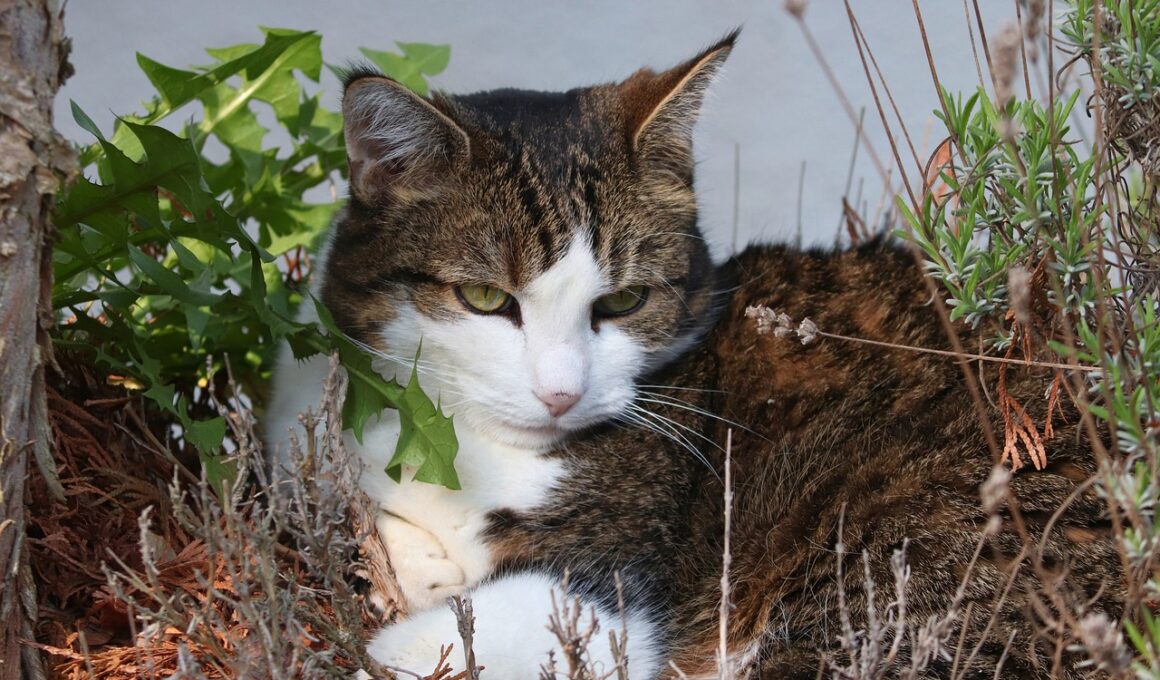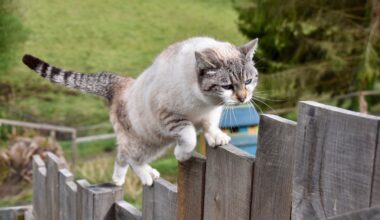Understanding Your Cat’s Desire to Investigate Hidden Spaces
Cats are notoriously curious creatures, often exploring their environment with fascinating zeal. Their investigative nature is rooted deeply in their instincts. When you observe your feline companion sneaking into boxes, crawling under beds, or peering behind curtains, you witness their natural behavior. This instinctual drive stems from their ancestors, who used exploration to find food, avoid danger, and establish territory. Understanding this desire to investigate hidden spaces is crucial for cat owners. It helps provide an enriching environment for your pet, tailored to satisfy these exploratory instincts. By offering safe, stimulating spaces within your home, you can keep your cat mentally and physically engaged. This includes creating hiding spots, utilizing cat trees, and providing interactive toys that encourage exploration. Allowing your cat to express their curiosity leads to a happier, healthier life. Moreover, this behavior can enhance the bond between you and your pet, building trust and affection. In the following paragraphs, we will delve deeper into why cats are drawn to hidden spaces, the psychological implications of exploration, and how you can create suitable environments that promote this behavior effectively.
Hidden spaces serve as a great source of comfort and security for cats. This aspect of cat psychology is deeply ingrained in their instincts as predators and prey. Cats enjoy squeezing into tight spots where they feel safe from perceived threats. These small environments often help them observe their surroundings while remaining inconspicuous. For many cats, a simple cardboard box or an open cupboard can become a fortress, creating a sense of safety. Such behaviors are not just playful antics. They also showcase problem-solving skills and intelligence, as cats must navigate their way into and out of these hiding spots. Furthermore, these explorations may lead to new discoveries, like finding a new toy or a cozy nook. This exploration boosts their confidence, promoting well-being and mental health. As a responsible cat owner, you can support this instinctual behavior by maintaining a cat-friendly home. Ensure your home has well-placed furniture, climbing structures, and even designated hiding spaces. Monitor their habits, adjusting as needed to keep the environment enjoyable and fascinating. Fostering this aspect of their behavior creates fun interactions and invaluable enrichment for your beloved feline.
Cats’ curiosity is driven by their senses. Cats possess keen eyesight, superior hearing, and an extraordinary sense of smell. All these attributes fuel their desire to investigate hidden areas. For instance, a mere rustle in a bush outside may captivate their attention. The urge to explore and investigate these sounds or movements keeps them engaged in their environment. When they encounter new scents, it stimulates their minds, triggering a thrill of excitement. As they explore hidden spaces, they often engage in scent marking, which reinforces their territorial claims. Providing an array of sensory experiences—through toys that mimic prey movement or engaging scents—can vastly satisfy their need for exploration. Understanding these nuances allows pet owners to facilitate healthy outlets for curiosity rather than simply discouraging it. Enriching the environment helps to stave off boredom and anxiety, preventing unwanted behaviors. Incorporating various stimulating elements fosters mental agility and encourages healthy play. It’s essential to recognize that while some curiosity and exploration may seem mischievous, they are, in fact, vital to maintaining a happy and stimulating environment for your feline friend. Thus, nurturing this trait will advance your relationship with your cat significantly.
Catering to Your Cat’s Exploration Instincts
One of the significant aspects of cat curiosity is that it can lead to mischief and sometimes destruction. However, this behavior affirms their intense curiosity and attraction to new spaces. To effectively channel this energy, establishing designated exploration areas within your home can work wonders. Such spaces can include cat condos, tunnels, and catnip-infused toys. These structures stimulate exploration while ensuring the safety of both your cat and your belongings. Cat trees are particularly beneficial, offering vertical spaces for climbing and jumping, which enriches their surroundings. Furthermore, you can use boxes, bags, or even blankets to build safe hideouts, activating your cat’s natural instincts to explore and play. Providing puzzles and interactive feeders can encourage them to problem-solve while engaging in an enriching activity. By carefully selecting safe and creative spots for your cat’s exploration, you cultivate an environment that embraces their natural tendencies. This not only satisfies their curiosity but also promotes physical activity and mental stimulation. Remember, a fulfilling environment ultimately contributes to their overall happiness and health.
When we consider a cat’s exploration habits, we must also acknowledge the factors that might trigger their desire to hide. Cats instinctively seek solace when they feel threatened or anxious. Sudden noises, unfamiliar visitors, or changes in their surroundings can push them to seek out hidden spaces for security. This behavior is entirely normal and stems from their natural instinct for self-preservation. As a cat owner, it is critical to recognize when your feline seems overwhelmed. By providing consistent reassurance during such times, you can ease their anxiety. Keep their favorite blankets or toys in places where they can retreat when feeling vulnerable. Creating a calm space, either through environmental changes or utilizing safe hiding spots, can alleviate stress. Encouraging exploration remains vital in ensuring their mental health, while also granting them comfort during their uncertain moments. Striking a balance between exploration and safe spaces is essential for promoting a robust personality in cats. Instilling confidence during these moments can help foster healthier coping mechanisms, ultimately improving your relationship with your beloved feline companion.
Understanding Your Cat’s Behavior During Exploration
Observation is key in understanding the depth of your cat’s exploration habits. Each cat has a unique personality, influencing how they investigate their environment. Some may approach new spaces cautiously, while others may burst forth with excitement. Observing how your cat interacts with hidden spaces reveals a lot about their confidence and curiosity levels. For instance, a shy cat might take longer to approach a new spot, using caution to evaluate the area first. Conversely, a more adventurous cat may dive right in without hesitation. Pay attention to their body language—the twitch of their tail, flattened ears, or the alertness in their posture can indicate excitement, curiosity, or anxiety. Creating a varied environment allows you to cater to different preferences. Provide a blend of thrilling hiding spots and safe retreats where they can feel comfortable. Regularly introducing new items will also maintain a sense of novelty and curiosity, ensuring they’re always engaged. By understanding these behaviors, you can effectively tailor the environment to cater to their psychological needs. This approach enhances their sense of well-being, ultimately leading to a happier, healthier life.
Your cat’s natural urge to explore hidden spaces is not just about physical activity; it’s also essential for their psychological development. This exploration fosters a sense of independence and boosts self-confidence in your cat. Engaging in investigations gives them a sense of control over their territory and surroundings. You may notice that cats who are allowed to explore hidden spaces are often more adventurous and less anxious overall. As such, integral to their well-being is providing opportunities for exploration. Encouraging this behavior is not only beneficial for their mental health but also ensures they remain active and engaged. A healthy level of curiosity can lead to better overall behavior and create a more harmonious home environment. Ensuring that your home is cat-friendly, with spaces for exploration and safe hiding spots, is crucial. Regular interactions and encouragement during their explorations further bolster their confidence, refining their social and physical skills. Building a strong bond with your feline friend means understanding and fostering these instincts. All in all, embracing your cat’s natural behavior will lead to a rewarding relationship for both of you.
The overall essence of understanding your cat’s curiosity lies in commitment and observation. By acknowledging their behavior and needs, you genuinely enhance their living experience. The journey of cat ownership becomes immensely enriching when you provide opportunities that encourage exploration while ensuring safety. Work to strike a perfect balance between excitement and security. Explore how to facilitate their natural quest for finding hidden spaces within your home. When you cater to their instincts and needs, you are not just providing a home; you are nurturing their psychological well-being. As owners, it’s vital to foster these instincts through thoughtful and intentional actions. Make informed decisions about creating spaces that allow them to play, explore, and recover. In tandem, remember to maintain an open heart and patience, as each feline will have its unique journey. Attuning to your cat’s curiosity will ultimately forge a deeper bond, creating cohabitation that is seamless and enjoyable. By cultivating an environment that inspires exploration and safety, both you and your cat can thrive together, fostering fulfillment and enriching experiences in the journey of companionship.


